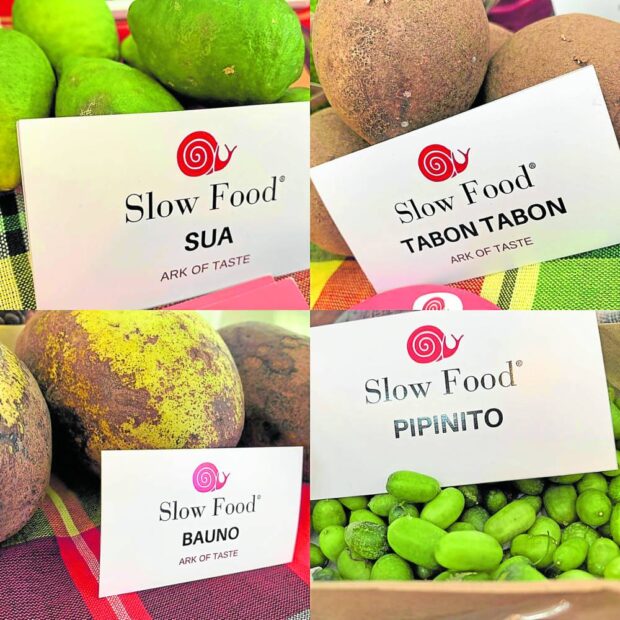Keep our indigenous culinary legacy alive

GOING LOCAL Slow Food once again highlights Philippine produce at the World Food Expo. —Photos from Chit Juan
It’s that time of the year again for the World Food Expo and another opportunity to promote Slow Food.
As you may know by now, Slow Food is a global grassroots organization that seeks to prevent the disappearance of local and indigenous produce as well as local food cultures and traditions. It is a movement that is now present in over 160 countries where advocates seek to ensure that people have access to good, clean and fair food.
Chit Juan of the Slow Food Movement shared that they once again joined the World Food Expo, where they educated people on local fruits such as sua, bauno, langkawas, batwan, pili, kulo, alibangbang, pipinito and tabon tabon. Now be honest, how many of those are you familiar with?
The Slow Food Movement catalogs these fruits. For instance, here is their website’s write-up on batwan:
“Batwan (Garcinia binucao) is a wild tree about 15 to 20 meters tall that grows in the forests of the Islands of Panay and Negros. Batwan bears fruits abundantly during the wet season and mature fruits hang on the main trunk and branches of the tree until harvested. Fruit is collected for both personal use and for sale on the market. A productive tree can give 50 to 100 kilograms of fruits in six months and there are estimated to be 5,000 productive trees on the two islands. There are two kinds of batwan, one with a thin skin and one with a thickened skin and flesh. The round fruits are 4 to 5 cm in diameter and contain four to six seeds. They are green in color, turning yellow when ripe. Their taste is sour, but not acidic and not very aromatic. They can also be eaten raw. Batwan is used as a souring agent in soups typical of the area. The soured broth, called sinigang, is not common in other parts of the Philippines. In Ilonggo cooking, it is considered the star ingredient in a dish called KBL, for kadyos (pigeon peas), baboy (pork) and langka (green jackfruit). Another common dish is paksiw, cooked with boiled batwan fruits. The fruits can also be preserved with salt and used as an appetizer. There is little documented history on the batwan tree, but it is known to have been used since before World War II. There is even a local riddle related to the species. It goes: ‘I went to the forest and saw many trees, but one (bat-wan) I like best. Which is it?’ Despite this established connection to the local culture, fewer people in the younger generations are using the traditional fruit in home cooking, due to the commercial souring agents now available for purchase in supermarkets.” (fondazioneslowfood.com/en/ark-of-taste-slow-food/batwan-2/)
Aside from this description, they clearly identify the state, region and production area of the fruit. So for instance, as recorded in their site, batwan is found in the Philippines, Region VI and produced in Negros and Panay Islands. It also identifies the fruit’s ‘indigenous community’ as Ilonggo.
Through the Slow Food Movement display at the World Food Expo, we learned that langkawas is from Davao; bauno is from Sulu, while pili and libas are from Bicol.
There were also demos performed to talk about quesillo or Cavite white cheese; the tilbok snack made from rice flour and coconut; and heirloom recipes made from labong or bamboo shoots.
Certainly, there are more fruits, recipes and culinary traditions to document. So each and every household must join the movement—not necessarily formally but let us inculcate and embody in our own daily lives the practice of appreciating homegrown produce and the determination to keep the culinary traditions of our ancestors alive!
